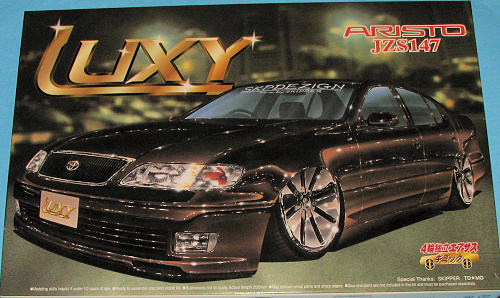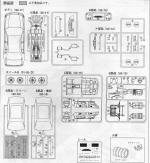
Aoshima 1/24 Toyota JZS 147 Aristo (Lexus GS 300)
| KIT #: | 030288 |
| PRICE: | $18.45 on sale at GreatModels ($36.95 SRP) |
| DECALS: | One option |
| REVIEWER: | Scott Van Aken |
| NOTES: |
Curbside |

| HISTORY |
Styled by the famous Italdesign Giugiaro firm, and equipped with an independent, double-wishbone suspension setup, the Toyota Aristo was launched in October 1991, offering two inline-6 powered versions for the Japanese market: the 3.0Q and 3.0V. The Aristo 3.0Q (codename JZS147) featured a 2JZ-GE engine which produced 226 hp (169 kW), while the Aristo 3.0V (JZS147) was equipped with a 24-valve twin-turbo 2JZ-GTE engine which produced 276 hp (205 kW). This twin-turbo engine was the same as could be found in the Toyota Supra RZ (JZA80). In 1992, a third model, the V8-powered 4.0Zi-Four (codename UZS143), joined the Aristo lineup. This model came with standard four-wheel drive and a 250 hp (186 kW) 1UZ-FE engine. This V8 had also been used in the first generation Lexus LS and the Toyota Crown Majesta. However, the only engine available for export markets was the 2JZ-GE inline-6.
Production of the Lexus GS 300 (JZS147) began on February 22, 1993 at the Tahara, Japan assembly plant. At the time, the GS represented the latest advancement of Tahara production technology, with only eight spot welds performed by hand. The rest, some 4,200 welds, were performed by robots. Italdesign Giugiaro's exterior styling blended elements of the original LS flagship and SC performance coupe in a rounded, aerodynamic shape, complementing the rest of the Lexus lineup. The vehicle adopted a wedge-like shape with high rear decklid, and longer and wider proportions than competing vehicles. The exterior shape of the original GS produced a drag coefficient of 0.31 Cd. Offered color schemes included single-tone bumper and body finishes, along with dual-tone schemes.
As Lexus' first rear-wheel drive sports sedan, the GS was placed above the front-wheel drive ES luxury sedan with its superior drivetrain setup, power and available amenities. The 3.0-liter 2JZ-GE inline-6 producing up to 226 hp (169 kW) and 210 lb·ft (285 N·m) of torque served as the powerplant. According to reviewer testing, 0–60 acceleration times for the GS 300 were clocked at slightly over nine seconds.
For the interior, the GS 300 featured walnut wood trim on the center console, leather seating, an automatic tilt-and-telescoping steering wheel, and the option of a Nakamichi premium stereo system. Driver and front passenger airbags were standard. A moonroof, remote 12-CD auto changer, and traction control (TRAC - left hand drive vehicles only) were options.
The GS was intended to take the price position of the original LS 400 flagship, which had moved upmarket since its 1989 launch. By the time of the GS 300's debut, the $35,000 initial base price of the LS had climbed to $47,000. The GS 300 carried an initial manufacturer's suggested U.S. base price of $37,930 at its debut. However, sales of the GS 300 were modest, with 1993 seeing the greatest sales at 19,164 sold that year. Sales dropped in later years as the Japanese yen rose in value against the dollar and made the vehicle more expensive than its rivals. Additionally, more powerful V8 sport sedans provided stiff competition. By 1997, the price of the GS 300 had risen to $46,195. Production of the first generation GS sedan ended in 1996.
| THE KIT |

| CONCLUSIONS |
An interesting model of a four door luxury sedan that, while perhaps not to everyone's taste, will make into a striking model depending on how it is painted.
| REFERENCES |
http://en.wikipedia.org/wiki/Toyota_Aristo
March 2012
I got this one on sale at GreatModels where there are great sales every week.
If you would like your product reviewed fairly and fairly quickly, please contact the editor or see other details in the Note to
Contributors.